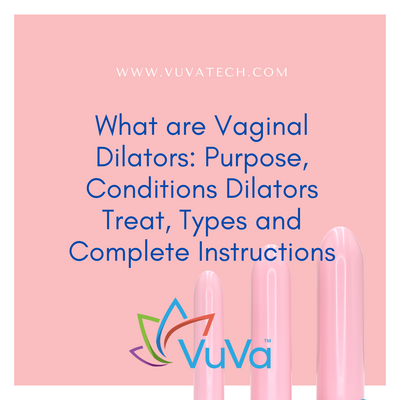
| Brett Farrow
Transgender Vagina After Surgery
Treating Tightness & Pain
Sex reassignment surgery (SRS) has many names. Some refer to it as gender affirmation surgery, sex reassignment, gender reassignment surgery, or sex-change surgery. Genitoplasty is the clinical term. Regardless of the name, transgender people change their genitalia to match their gender identity.
The process is not something that happens overnight but requires years of counseling, hormone therapy, and lifestyle changes before the change from male to female (MTF) or female to male (FTM). (1) After SRS, the transgender vagina may experience tightness and pain.
Treatment of tightness and pain
Gender reassignment surgery is considered very safe, and complications are not common. However, to help ease any tightness and pain after the procedure, post-op instructions include using a vaginal dilator. (2) (3)
Vaginal dilators are tube-shaped devices that come in various sizes to help stretch and lengthen vaginal tissue and ease scarring. VuVa™ Dilators come in medical-grade plastic and are entirely safe to use. Some dilator choices have Neodymium magnets that help flood sensitive vaginal tissue with healthy blood flow. Each set comes with a complimentary storage bag for discreteness.
Transgender women use the dilators in the weeks after surgery to maintain vaginal depth and elasticity. Physical therapy helps alleviate any tightness and pain from SRS and is an integral part of recovery.
Using vaginal dilators
- Your doctor will give you dilation instructions, but generally, the best dilator practices for the transgender vagina include the following:
- Begin with the smallest dilator possible to ensure that you have minimal discomfort. You can always go up in size as your vaginal capacity increases.
- Choose a quiet place alone for therapy. It's essential that you feel safe and without the possibility of being interrupted.
- Make sure you clean your dilator before use to ensure that no bacteria or germs enter your vagina. Pat the vaginal dry after washing it with antibacterial soap and water.
- Apply a water-based lubricant to the dilator to help with insertion. With vaginal dilators, you don't want to use silicone-based oils.
- In a comfortable place, lie on your back with your knees bent. Open your legs wide and slowly insert the dilator. It's essential to take it slow and only go as far as you can handle. Your vagina may be extremely tight and tender.
- If the pain isn't severe, gently insert the dilator into the vaginal cavity at a 45-degree angle, under the pubic bone, and then pressing straight inside.
- There may be a small amount of pressure and resistance. Don’t push yourself too quickly, and if there’s extreme pain, stop and try again later.
- If possible, insert the dilator into the vagina as far as possible. Your goal is to reach the full depth of the vagina. For 10 minutes, leave in place to receive the full benefit of dilatory therapy. If you can leave the dilator inside the vagina longer, then the treatment is more effective sooner.
- You may start using dilation therapy as soon as your vagina has healed. The typical schedule is three times per day for three months. However, consult with your doctor before treatment.
- Start with the smallest size and then increase the volume after three months or when you begin to feel comfortable.
- Follow the schedule outlined by your doctor, but plan on using the dilators within the first three months after surgery for about 10 minutes at three times per day. As your vagina begins to stretch, you can slowly decrease your dilation schedule—for example, 3-6 months after surgery one time per day for 10 minutes.
- At any point, your vagina begins to feel tight, increase the dilator size, and dilation schedule to ease the tightness. Every few months you should go up one dilator size.
- After each use, wash and store in a safe place.
VuVatech Dilators are made in the USA. Ships Discreetly. www.vuvatech.com
How is the transgender vagina formed?
Gender reassignment surgery is a kind of plastic surgery that includes two different classifications of surgical procedures. The first type is the top surgery. The operations in this category include reshaping their chest to fit a male or female form.
Breast augmentation is when males transitioning to females enlarge their breasts. Facial feminization is when the face is reshaped to appear more feminine. Some examples of facial feminization are shortening the forehead to make it smaller and reshaping the lips and jaw to look more feminine. (4)
The other type of surgery is in a classification called bottom surgery. Bottom surgery includes phalloplasty, (5) metoidioplasty, and vaginoplasty. Vaginoplasty procedures are changing the male genitalia to female genitalia, and the most common is the penile inversion procedure to form the vagina.
Penile inversion procedure
The operation, considered the gold standard by the Center of Excellence for Transgender Health, uses the penile skin to form the vaginal lining. The labia minora and labia majora make up the scrotal skin, and the new clitoris takes the sensitive skin at the top of the penis. In some cases, there's not enough skin left to form the complete depth of the vagina canal. When this happens, a skin graft or extra skin from the abdomen or thigh helps complete the vagina cavity. (6)
Genital surgery usually takes two to five hours. Afterward, the transgender woman stays for a few in the hospital for monitoring and healing. There may be some vaginal discharge for 4-6 weeks. Post-op instructions include using a vaginal dilator (once healed) to help stretch and lengthen the vagina.
Maintaining vaginal and transgender health after having SRS is extremely important. The single best way to ease pain and tightness is through using vaginal dilators. Vaginal dilators have no side effects and are useful in maintaining the elasticity of your vagina naturally. Thousands of women use them to ensure a healthy vagina and sex life
- https://www.ncbi.nlm.nih.gov/pmc/articles/PMC4154336/
- https://marcibowers.com/transfem/gav/post-op-care/
- https://www.hindawi.com/journals/bmri/2018/4907208/
- https://transcare.ucsf.edu/guidelines/vaginoplasty
- https://www.mayoclinic.org/tests-procedures/facial-feminization-surgery/about/pac-20467962
- https://www.hopkinsmedicine.org/center-transgender-health/services-appointments/faq/phalloplasty
Is intercourse painful as well? Learn more about VuVa Vaginal Dilator Therapy and Dyspareunia here.
Do you need to order vaginal dilators so you can start your pelvic floor therapy process? Made in the USA. Visit www.vuvatech.com
VuVa Helpful Links:
How do Neodymium Vaginal Dilators work?
7 Reasons for a Tight Vagina and How to Loosen
How to Relax Vaginal Muscles, Vaginismus & Sex
Vaginal Stretching - Keeping in Shape with Dilators
Do Dilators Really Work? Yes, and They can Improve Your Sex Life!
Shop for VuVa Vaginal Dilators
Tara Langdale Schmidt is the inventor of the VuVa Dilator Company. She has pelvic floor dysfunction herself and wanted to create a dilator set that is made in America that women can trust. VuVatech has been in business since 2014 and has helped over 50,000 women all over the globe. She patented the Neodymium Vaginal Dilator, that is clinically proven to help with blood flow and nerve pain.














